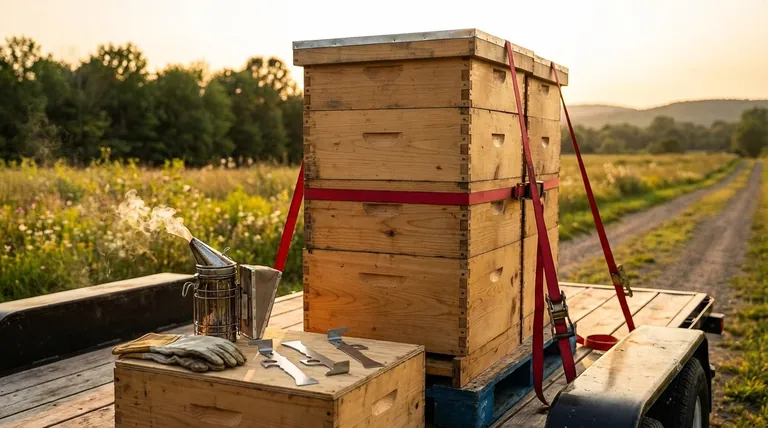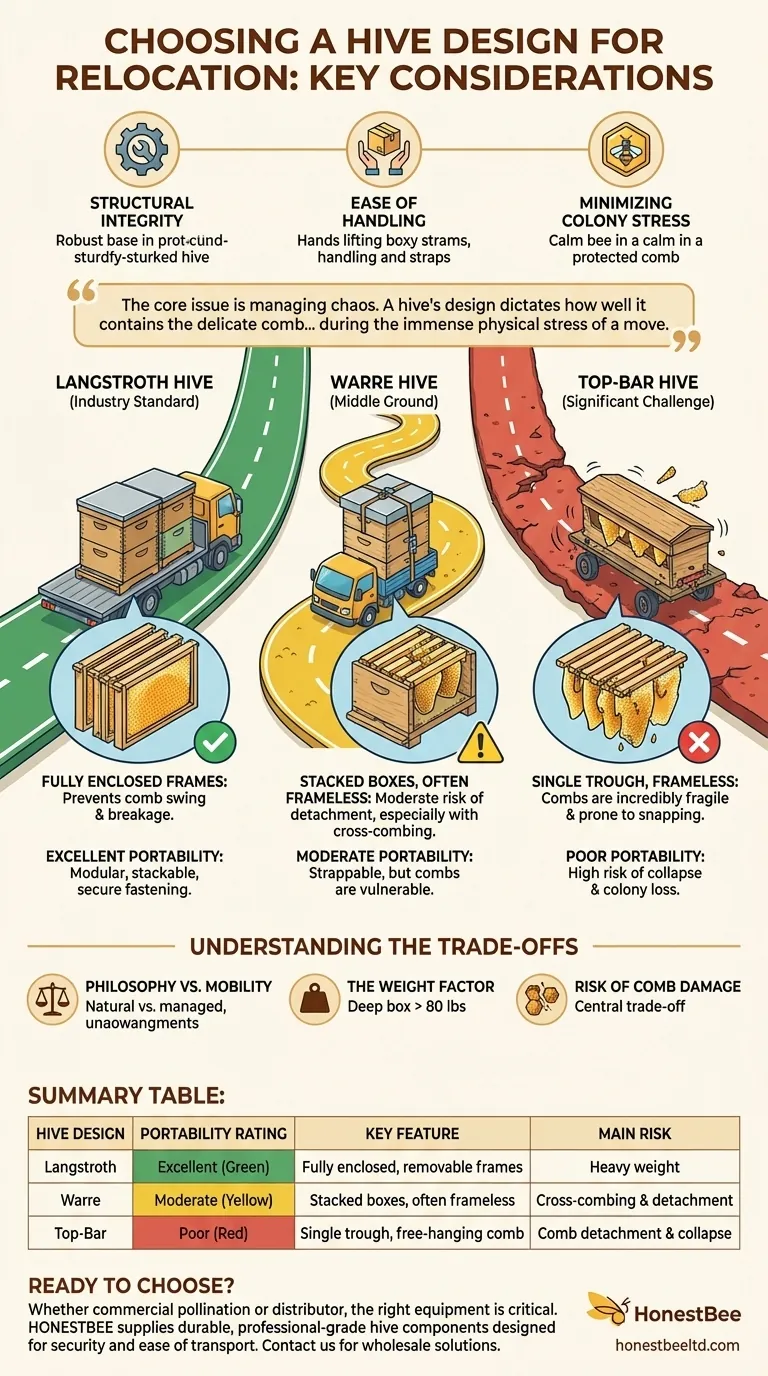For beekeepers planning to relocate hives, the most critical considerations are the hive's structural integrity, its ease of handling, and the level of stress inflicted upon the bee colony during transit. While any hive can be moved, designs with fixed, enclosed frames like the Langstroth are overwhelmingly superior for this task, as they are specifically engineered to prevent internal damage and can be securely fastened for transport.
The core issue in hive relocation is managing chaos. A hive's design dictates how well it contains the delicate comb, the colony, and the honey during the immense physical stress of a move, making the Langstroth hive the professional standard for mobility.

Why Hive Design is Critical for Relocation
Moving a colony of 50,000 bees is a delicate operation. The hive's architecture is the single most important factor in determining the success and safety of the move.
Minimizing Colony Stress
A rough transit can be catastrophic. Bumps and vibrations can cause combs to detach, crushing bees and spilling honey, which can lead to robbing or drowning the colony. A stable internal structure is paramount.
Ensuring Beekeeper Safety and Ease
A well-designed hive for relocation is easy to seal completely, preventing bee escapes. It should also have standardized components that are easy to lift, stack, and strap down securely.
Maintaining Structural Integrity
The hive itself must withstand the forces of being lifted, tilted, and jostled. Hives with loose or poorly supported internal components are at high risk of collapse, endangering the entire colony.
Comparing Common Hive Designs for Portability
Different hive philosophies lead to designs with vastly different suitability for travel. The key distinction comes down to one feature: frames.
The Langstroth Hive: The Industry Standard
The Langstroth is the globally dominant design precisely because of its portability. Its modular, rectangular boxes and removable frames are its greatest assets.
The frames provide a rigid four-sided support for the wax comb. This prevents the comb from swinging, breaking, or detaching from the top during transit.
Furthermore, the standardized box dimensions make Langstroth hives easy to stack securely and strap together, turning a multi-part hive into a single solid block for moving.
The Top-Bar Hive: A Significant Challenge
The Top-Bar Hive (TBH) is designed for stationary, natural beekeeping. Its single, long trough contains bars from which bees draw their own comb freely.
This design is extremely poorly suited for relocation. The combs are attached only to the top bar, making them incredibly fragile. The slightest jolt can cause a heavy comb full of honey or brood to snap off, creating a domino effect of collapse inside the hive.
Moving a top-bar hive is a high-risk procedure that should only be attempted when absolutely necessary and with extreme care.
The Warre Hive: The Middle Ground
The Warre hive uses stacked boxes like a Langstroth but is often managed without frames, using only top bars similar to a TBH.
This makes it more portable than a top-bar hive, as the boxes can be strapped together. However, it still carries the significant risk of comb detachment because the combs are not fully supported.
If cross-combing (where bees connect combs to the hive walls) has occurred, the risk of damage during a move increases dramatically.
Understanding the Trade-offs
Your choice of hive often reflects your beekeeping philosophy, but you must understand the physical consequences of that choice when it comes to relocation.
Portability vs. Beekeeping Philosophy
Langstroth hives are built for management and efficiency, including movement. Top-bar and Warre hives are designed to more closely mimic a natural bee cavity, prioritizing bee autonomy over beekeeper intervention. This "natural" design inherently makes them less stable for transport.
The Weight Factor
A deep Langstroth hive box full of honey can weigh over 80 pounds (36 kg). While modular, their weight can be a significant physical challenge for the beekeeper during a move.
The Risk of Comb Damage
This is the central trade-off. A fully-framed Langstroth hive secures the colony's "nursery" and "pantry." Frameless designs like the Top-Bar or Warre leave these critical structures vulnerable to total destruction during a move.
Making the Right Choice for Your Goal
Select a hive design that aligns with your long-term plans, especially if you anticipate moving your bees for pollination, property changes, or managing swarms.
- If your primary focus is commercial pollination or frequent moves: The Langstroth hive is the only professional and reliable choice due to its unmatched structural security.
- If your primary focus is hobby beekeeping with a possible one-time move: A Langstroth hive remains the safest and most straightforward option, minimizing risk to your bees.
- If your primary focus is stationary, natural beekeeping: Top-Bar and Warre hives are excellent choices, but you must accept that relocation is a highly hazardous event for the colony.
Choosing your hive with an eye on future mobility ensures the long-term safety and success of your colony.
Summary Table:
| Hive Design | Portability Rating | Key Feature for Relocation | Main Risk |
|---|---|---|---|
| Langstroth | Excellent | Fully enclosed, removable frames | Heavy weight |
| Top-Bar | Poor | Single trough, bars with free-hanging comb | Comb detachment and collapse |
| Warre | Moderate | Stacked boxes, often frameless | Cross-combing and detachment |
Ready to Choose the Right Hive for Your Apiary's Needs?
Whether you're a commercial apiary planning frequent relocations for pollination services or a beekeeping equipment distributor seeking reliable, portable hive solutions, the right equipment is critical for protecting your investment and ensuring colony health.
HONESTBEE supplies commercial beekeepers and distributors with durable, professional-grade hive components designed for security and ease of transport. Our wholesale-focused operations ensure you get the robust Langstroth equipment and secure fastening systems needed for safe, successful hive moves.
Contact HONESTBEE today to discuss your hive relocation requirements and discover our wholesale solutions for commercial-scale beekeeping.
Visual Guide

Related Products
- HONESTBEE Advanced Ergonomic Stainless Steel Hive Tool for Beekeeping
- Professional Dual-End Stainless Steel Hive Tool for Beekeeping
- Professional Galvanized Hive Strap with Secure Locking Buckle for Beekeeping
- Professional 3-Bar Frame Grip with Integrated Hive Tool
- Professional Pneumatic Wire Embedder for Beehive Frames
People Also Ask
- What is a hive tool and what are its uses? Master Your Hive Inspections with the Essential Beekeeper's Tool
- Why do hive tools have a hole? Unlock the Secret to Efficient Beekeeping
- How should beekeepers handle bees when using a hive tool? Master Calm, Deliberate Techniques
- What tools are used for cleaning frames? A Beekeeper's Simple 4-Tool Guide
- What is the hole in a hive tool for? A Multi-Tool for Apiary Repairs and Maintenance



















